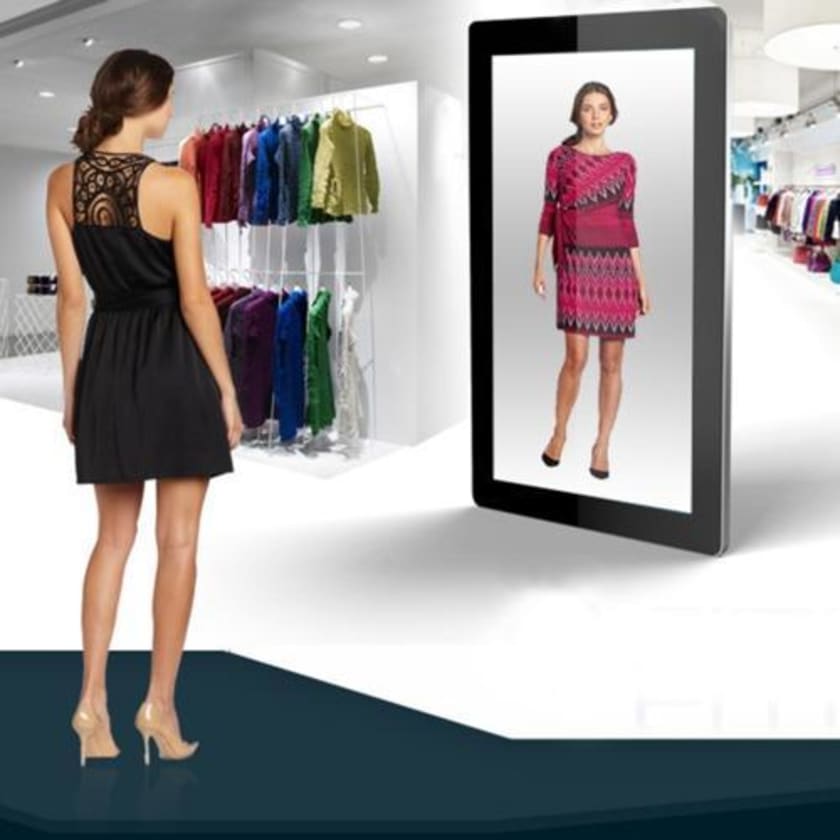Are Virtual Mirrors The Next New Thing In The Fashion Retailing?



Introduction
We live in the era of digital domination and rapid urbanization, and customer demands are growing in tandem with the scale at which manufacturing processes are conducted. Over the past few years, e-commerce has gained immense popularity. Creating a good e-commerce customer experience seems like a lot of pressure, right? For most customers, the quality of each e-commerce experience plays a significant role in whether they return for a subsequent one. Despite the popularity of e-commerce platforms, servers reveal that customers return 70% of their total apparel order within 2-3 days of receiving the items they purchased — not an ideal scenario for an e-commerce business owner.
The primary reason for most product returns seems to be issues related to "inappropriate fitting." While e-commerce is a convenient option, it does not allow customers to try before they buy like they might be able to in a brick-and-mortar store. As a result, it may not be able to match the in-shop experience, where customers get the chance to browse their options in person and try on clothes for size before making a purchase.
Although e-commerce platforms began gaining long before the COVID-19 pandemic, pandemic-related precautions have greatly sped up the evolution and increase in the popularity of online shopping. So, how can the in-store experience be somewhat replicated over the internet while still offering consumers a seamless, convenient, and safe shopping experience? This is where virtual mirrors can come into play.
What are virtual mirrors?
Backed by great technology such as augmented reality, virtual mirrors are regarded as the fashion industry's future where customers can check the fit without actually trying on the clothes. Virtual mirrors is a recently launched concept that shows the fitting of a clothing piece on you without any hassle of physically trying it out. It is enabled with motion rendering technology, allowing users to view from various angles different exposures of light and when in motion. The best part is it is highly accurate and shows the proper fitting without any bottlenecks. A customer can try on several outfits in less time and effort through the virtual mirror. Additionally, it supports instant purchases.
Augmented reality, better known as AR, is the 21st-century technology that offers an interactive user experience of real-world scenarios. In simple terms, augmented reality can be described as a seamless combination of users' environment and digital information in real-time. Unlike VR or virtual reality, known for developing an artificial experience, AR is designed to offer real-world environment experiences while providing additional information to all users.
How do virtual mirrors work?
A virtual mirror is equipped with augmented reality technology and Radio Frequency Identification, which acts as a fitting room. Every time a user brings a cloth piece, for example, a t-shirt, in front of the mirror, the virtual mirror scenes its image, and the user develops a virtual model who is actually wearing the clothing. Every time the user turns or moves in different angles to overview the fitting, the virtual model shown in the mirror also darts to move accordingly in real-time to display.
Virtual mirrors have been the talk of the town, especially in the fashion industry. Several renowned online stores are benefitting from the concept of virtual mirrors and allow their customers to feel the product and check the fitting. Today, this concept is also used as an s marketing tool as it attracts users from all around the world.

Who is using virtual mirrors?
Not just small brands or customers, the concept of virtual mirrors have successfully attracted the biggest names in the fashion industry. Right from brands like H&M, Ralph Lauren, Lacoste, Zara, and Burberry are all benefitting from virtual mirror technology.
When talking about virtual mirrors, it is impossible not to mention Burberry, a UK fashion house famously known for its trench coats. It is now popular to employ virtual mirrors in its stores. Burberry is a luxury fashion brand that uses AR technology for a better selection of goods without even trying. Its focus on digital implementation was an effective strategy that drew the attention of increasing retail stores. The invention of virtual mirrors is an exclusive system. Burberry established this system to deliver information and audio play. Although the brand faced a 10% loss, it is still one of the front runners in the luxury market.
The AR-powered virtual mirrors are substituting the trail rooms and becoming an integral part of online and in-store shopping. As a result, the way of shopping has taken a 360-degree turn. So, if you're someone who gets fascinated by technology and the fashion industry, these virtual mirrors can be your new obsession.
Virtual mirrors - How can they help your business to grow?
Virtua mirrors are a relatively newer concept and technology that has grabbed most eyeballs in the least amount of time. It is a technology where users can check the fit and look without trying on fashion items such as clothes, shows, and so much more. This concept has gained immense popularity and provides improved customer engagement. The best part is backed by augmented reality, which means that the user gets to experience the real-world environment through body language and natural gestures. It saves ample time and effort.
Additionally, it allows users to try on a range of clothes without stepping into the hassle of trying each piece of clothing. Virtual mirrors are best suited in the trial rooms in the fashion industry as customers do not have to wait in long queues, nor do they have to return the garment because of fitting issues. All they need is to stand in front of the mirror and check themselves out. If they feel the fitting is pretty satisfying, that's it! The times have changed, especially after the coronavirus outbreak, which forced everyone to lock themselves inside their houses and follow safety protocols. Although we're out of those times, precautions must be taken against getting trapped.
Conclusion
Collecting customer data is one of the most effective practices in the fashion industry. Several small-scale businesses do not actively participate in customer data collection, sometimes leading to unsatisfactory results. Customer experience is the most influential thing that drives you to perform better each passing day. The fashion industry is growing, and a large credit goes to the introduction of virtual mirrors, which brought an unsaid storm. You no longer have to wait to queue or return products because of size issues, as this is solved by AR technology. So, if you're looking to delight your customers, the virtual mirror can help you strike all notes rightly.

Eager to know more about virtual mirrors and their functioning, Visit Fashinza!



















